I was exhausted and disheartened, and I had resigned from my job. I saw no light at the end of the tunnel because there was none. For a dozen years, I toiled away in the corporate world, driven by the singular goal of advancing my career. My life was consumed by meticulous planning as I carefully calculated my earnings and savings, all while keeping a watchful eye on my loan repayments and other expenses. For a dozen years, I endured a relentless onslaught of anxiety, misconduct, stress, fear of failure, and depression that sapped my physical and mental strength, leaving me utterly drained. I needed to break free from this conventional mold of existence. I needed to escape. It was at that moment that I conceived the idea for my very first trek, to Kedarkantha. “Escape to Kedarkantha” is an engaging narrative of my experiences at Kedarkantha, a mighty peak in the Himalayas of Uttarakhand, India.
For those with an unquenchable thirst for adventure, a trekking holiday is the ultimate escape. It offers the perfect opportunity to satisfy one’s love of traveling and explore the unknown. The experience of trekking has the power to deeply resonate with one’s innermost being. It has the ability to touch the soul in a profound way, leaving a lasting impression that can be felt long after the journey has ended.
But the question that causes the most doubt when planning a trek is, “Can I do it?” Am I physically fit enough? Will I get sick? Would I be able to maintain personal hygiene? What about the food? Now, these questions are relevant, but with adequate planning and preparation, anything is possible. Despite the fact that completing a trek can be a rewarding and life-altering experience, it can also be a major disappointment if you are unprepared.
So, what did I do successfully to complete my trek to Kedarkantha?
Improve My Fitness Level

I anticipated that the journey to the Himalayas would be notoriously difficult. They require walking for days over steep inclines across an uncharted terrain of rocks, streams, and snow while carrying a backpack weighing between 40 and 60 kilograms, depending on its contents. And as I climb higher, the atmosphere will become thinner due to the high altitude, requiring my heart to work harder in order to consume more oxygen.
In light of the fact that every awe-inspiring trekking expedition begins with a solitary step, it was vital for me to get into shape before taking that first step. I began by stretching to increase my overall body flexibility. In addition, I engaged in strength training in order to improve the health of my muscle tissue, bones, and joints. Priority was always given to leg exercises such as squats, lunges, leg curls, leg presses, and other leg extension exercises. In addition, running, skipping, climbing, and jogging were crucial for enhancing cardiovascular health. Prior to the trek, I followed a healthy exercise regimen for a few months to improve my cardiovascular health, which provided me with the necessary fitness and confidence to complete the trek.
Assess The Difficulty Level
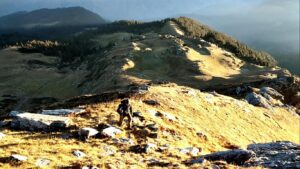
As I was planning my first trek, I was cautious about its level of difficulty. In general, a trek is divided into four levels of difficulty based on terrain, weather conditions, water sources, altitude, and exit routes. They range from easy to moderate, moderate to difficult, and difficult. Fortunately, Kedarkantha belonged to the “easy to moderate” category, but it was still difficult enough to complete.
Length Of Trek
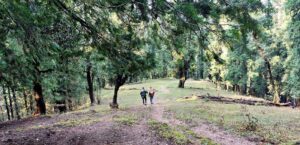
The trek to Kedarkantha spans a distance of 20 kilometers and ascends to a height of 12,500 feet, requiring approximately six days to complete. As a novice adventurer, I made the wise decision to embark on a trek that would not last for more than a week. My primary focus was acquiring the essential experience required for future trekking expeditions. With great anticipation and ample preparation, I set out on a trek that promised to be short but lengthy and challenging. However, I soon realized that the true measure of my journey would not be determined by my own physical endurance but rather by the limits of my body’s capacity to sustain such an endeavor.
When To Go

The enjoyment of my trek was contingent upon the timing of my departure. Kedarkantha in the winter, when the mountains are covered in snow, is therapy for the eyes and the soul. But, during the winter, the once familiar terrain transforms into a formidable obstacle, demanding more from the intrepid adventurer. More layers of clothing, gear, food, medicine, and hygiene necessities mean a heavier backpack. Acclimatization can also prove to be a challenge if the body finds it difficult to adapt to the prevailing conditions.
Therefore, I decided to travel in October, when the weather would be at its majestic best. And I was correct. The ever-shifting landscape, the excitement of sleeping beneath a star-lit night sky, and the stillness of the thick woodland proved to be both exhilarating and mesmerizing. The verdant greenery and lush landscapes that surrounded me were a sight to behold, and the myriad collections of flora that dotted the terrain only added to the breathtaking scenery. As a trekker, I had longed to experience the amazing wonders of the mountains, and I was not disappointed.
What To Pack
This is where I made my first mistake. As a first-time trekker, I ended up packing a large number of items that I did not need. Please review the diagram below and compile a list of items that are an absolute requirement.
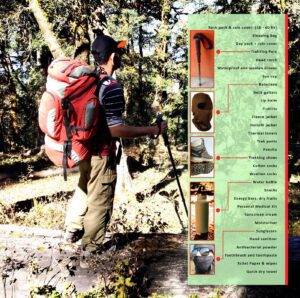
About Kedarkantha
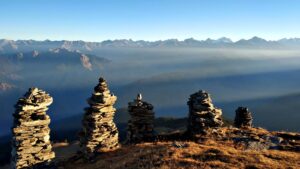
The Kedarkantha Peak, situated in the Western Garhwal region of the Uttarkashi district of Uttarakhand, is a coveted trekking destination in India. Its breathtaking natural panoramas and the alluring charm of the snowcapped peaks make for a truly enchanting experience. At an elevation of 3810 meters lies a trekking trail that invites nature enthusiasts to revel in the splendor of the unspoiled, dense pine forest. Here, one can relish in moments of pure bliss while experiencing the thrill of adventure.
![]() 30 Essentials For The Complete Man
30 Essentials For The Complete Man
About The Trek
The trek towards the beautiful Kedarkantha summit commences from the city of Dehradun and begins in Sankri village. The Kedarkantha Trek is a captivating and exhilarating journey, offering ample thrills with minimal challenges and in a shorter duration that is conveniently reachable from Dehradun, a transportation hub accessible from all corners of the nation. The trek is remarkably economical and can be enjoyed with utmost comfort and convenience.
Detailed Itinerary
Day 01: Arrival at Sankri
From the bustling city of Dehradun, the enchanting and alluring Kedarkantha Trek began. I had arrived in Dehradun the day before. The journey from Dehradun to Sankri spans a distance of 187 kilometers and took approximately 7 hours to complete. Sankri, a quaint little town, is nestled at an altitude of 2,100 meters. At Sankri, I was greeted by a breathtaking panorama of lush meadows, thick pine groves, gushing streams, and exquisite maple trees.

With the evening free of restrictions, I had the freedom to enjoy myself indoors or venture out and discover the charming Sankri village, full of native boutiques and a modest marketplace. In this region, phone service proves to be rather undependable, so making calls was challenging. Yet, gazing upon the setting sun over the Himalayas from Sankri was a truly magnificent sight to behold. I ended up savoring the regional flavors of the local cuisine by dining at the roadside food stalls.
Day 2: Sankri to Juda-ka-Talab
Through an addition known as Sor, the trek to Juda-ka-Talab, which is based at an altitude of 9100 feet, began from Sankri village. The trek was 4 kilometers long, and it took roughly 5 hours to get there.
Beyond the village, the road meanders in a wide arc before embarking on a sharp incline. The ascent began with a series of crossings over bridges and streams, weaving through a dense forest of towering trees. The ground beneath was blanketed in a thick layer of maple and pine leaves, all of which had taken on a rich, autumnal hue. The trail presented a breathtaking graphical view that captivated all who witnessed it.
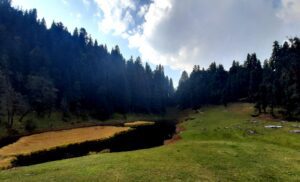
After arriving at Juda-ka-Talab, I noticed the striking contrast between a sizable pool of water to the left and a thicket of pine and oak trees to the right; it was a captivating display that Mother Nature herself had created. It was a prime location for a campsite, where we engaged in activities such as photography and meditation. We even took a leisurely stroll to explore the surrounding area. Under the star-lit night sky, the campfire provided an idyllic backdrop for non-stop banter and group discussions. Overnight sleeping was arranged in tents.
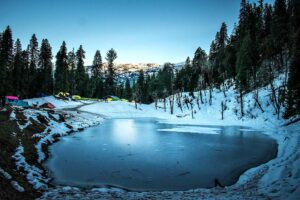
Day 3: Juda-ka-Talab to Kedarkantha Base
The journey from Juda-ka-Talab was nothing short of intoxicating as we made our way towards the Kedarkantha base, situated at an altitude of 11,250 feet. The journey spanned approximately 4 kilometers and, at a moderate pace, required 2.5 hours to arrive at the destination.
As I approached the Kedarkantha Base, my eyes were drawn to a magnificent sight: an arc-shaped range of snow-capped mountains, including the majestic Bandarpoonch, Swargarohini, Kala Nag, and Ranglana. These peaks stood tall and proud; their beauty was on full display for all to see. Overnight sleep was arranged in tents, but as the night drew near, the frigid wind was at its merciless best.
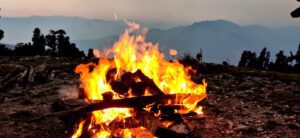
For photographers, there is perhaps no greater thrill than attempting to capture the vast expanse of the Milky Way as it stretches across the night sky, casting a shimmering glow upon the majestic mountain peaks below. With shooting stars streaking across the heavens, the experience is nothing short of awe-inspiring, leaving an indelible impression on the mind.
Day 4: Kedarkantha base to Kedarkantha peak; descend back to Hargaon camp
On the fourth day, the day’s itinerary consisted of a challenging trek to the summit of Kedarkantha from 11,250 feet to 12,500 feet, followed by a descent back to the Hargaon campsite nestled at an elevation of 8900 feet. The journey in its entirety was 6 kilometers and required approximately 7 hours to complete at a moderate pace.

The journey commenced in the wee hours of the morning, precisely at 2 A.M. The aim was to witness the sun’s radiance gracing the peak of Kedarkantha. The path ahead was dark and treacherous at every turn. The ground was slick with moisture, making each step a precarious one. The forest was thick, casting deep shadows that obscured the way forward. And as the trail became higher, the incline grew steeper, demanding every ounce of strength and determination from those who dared to venture forth. As our journey continued, fatigue began to set in, for we were climbing at a constant pace to reach the peak before sunrise. But the moment we gazed at the night sky, the fatigue dissipated, for the sparkling stars seemed to beam down upon us with a reassuring smile, urging us to keep pushing forward.
As the summit drew near, the rocky path seemed to whisper the promise of an unimaginable experience, one that I had never encountered before. The ascent was perilous, yet it inspired me onward, embarking me on a quest to uncover the marvels that awaited me. With the first break of the morning light, the lush terrain stretched out before me in a tapestry of colors that dazzled my senses with their brilliance. Each shade seemed to outdo the last, creating a kaleidoscope of vibrant hues that was nothing short of breathtaking. Finally, when I reached the summit, I sat down in silence to absorb the captivating splendor. I became entranced, and the passage of time became invisible, as if I had been transported to a surreal universe. The experience was unforgettable and etched into my memory for all time.
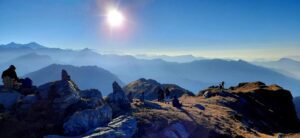
Atop the mountain’s summit rests a diminutive yet exquisite temple, dedicated to the revered deities Lord Shiva and the goddess Parvati. There is also a small shrine dedicated to Lord Ganesha. The awe-inspiring views of the snow-capped mountains of Uttarakhand left me dumbfounded and at a loss for words.
After being mystified by the heavenly glory of the peak, we began our descent back to the base camp. After reaching the camp, we took a break for lunch and descended further to Hargaon camp, a journey back through dense oak forests, pine trees, shepherd huts, and flowing streams. We set up a campfire and spent the moonlit night discussing our experiences reaching the summit.
Day 5: Hargaon camp to Sankri

On day 5, we made our descent from an altitude of 8900 feet to 6400 feet. The path spanned a distance of 6 kilometers and required approximately 4 hours to travel at a moderate pace. As we wandered through the lush, verdant pine forests, we eventually reached a ridge that offered a breathtaking vantage point of the Har ki Dun valley, also known as the Valley of Gods, in all its serene and idyllic glory. As we delved deeper into the thickets, signs of human settlement began to emerge. By sunset, we had arrived at Sankri.
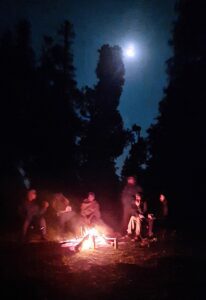
Day 6: Departure day (Sankri to Dehradun)
On the 6th day of our journey, we embarked on a 10-hour return trip to Dehradun via NH123, spanning a distance of 220 kilometers. Although there were various routes to choose from, NH123 proved to be the most efficient option due to its shortness and minimal traffic congestion. On our ride back, our faces were drowning in exhaustion but visible with an unmistakable sense of despair at bidding farewell to the majestic Kedarkantha Peak. Fatigue had set in, yet our hearts wanted to go back.
My trek to Kedarkantha was a profound experience that allowed me to fully appreciate the splendor of existence. Through the experience of encountering the natural world in all its purity, I gained a deeper understanding of my place in this world with each step. The majesty of the mountains, the serenity of the forests, and the vastness of the sky all served to remind me of the magnificence of life, which enabled me to see the world in a new light.

To conclude, trekking, with its inherent challenges and rewards, offers a unique opportunity for self-discovery. The physical exertion required to navigate the rugged terrain and the mental fortitude needed to overcome these obstacles can reveal one’s true character. As the trekker pushes beyond their comfort zone, they may confront fears and limitations that will help them gain a deeper understanding of themselves in the process. The solitude and natural beauty of trekking can also provide a space for introspection and reflection, allowing the trekker to connect with their innermost thoughts and emotions. Through this journey of self-discovery, the trekker may emerge with a newfound sense of confidence, resilience, and purpose.
The world is a big place, and its natural splendor is a sight to behold. There is so much to explore, and one lifetime is not enough to witness its infinite wonders. If your heart wishes to embrace the untamed spirit of freedom and if your mind longs for the serenity of peace, then listen to the whisper of the mountains. Her voice echoes through the clouds. She is calling for you. She is waiting.
Creating content and capturing images requires time and effort. I am extremely appreciative to the designers, photographers, and artists whose images helped me complete this article. Please note the image attributions used in the preceding content.
FEATURE IMAGE
Photo by Vidhey PV on Unsplash
Magnificent view of mid range Himalayas from kedarkantha peak
Juda Ka Talab during winter
https://commons.wikimedia.org/wiki/File:Juda_Ka_Tabal.jpg
Sanket Barik, CC BY-SA 4.0 <https://creativecommons.org/licenses/by-sa/4.0>, via Wikimedia Commons
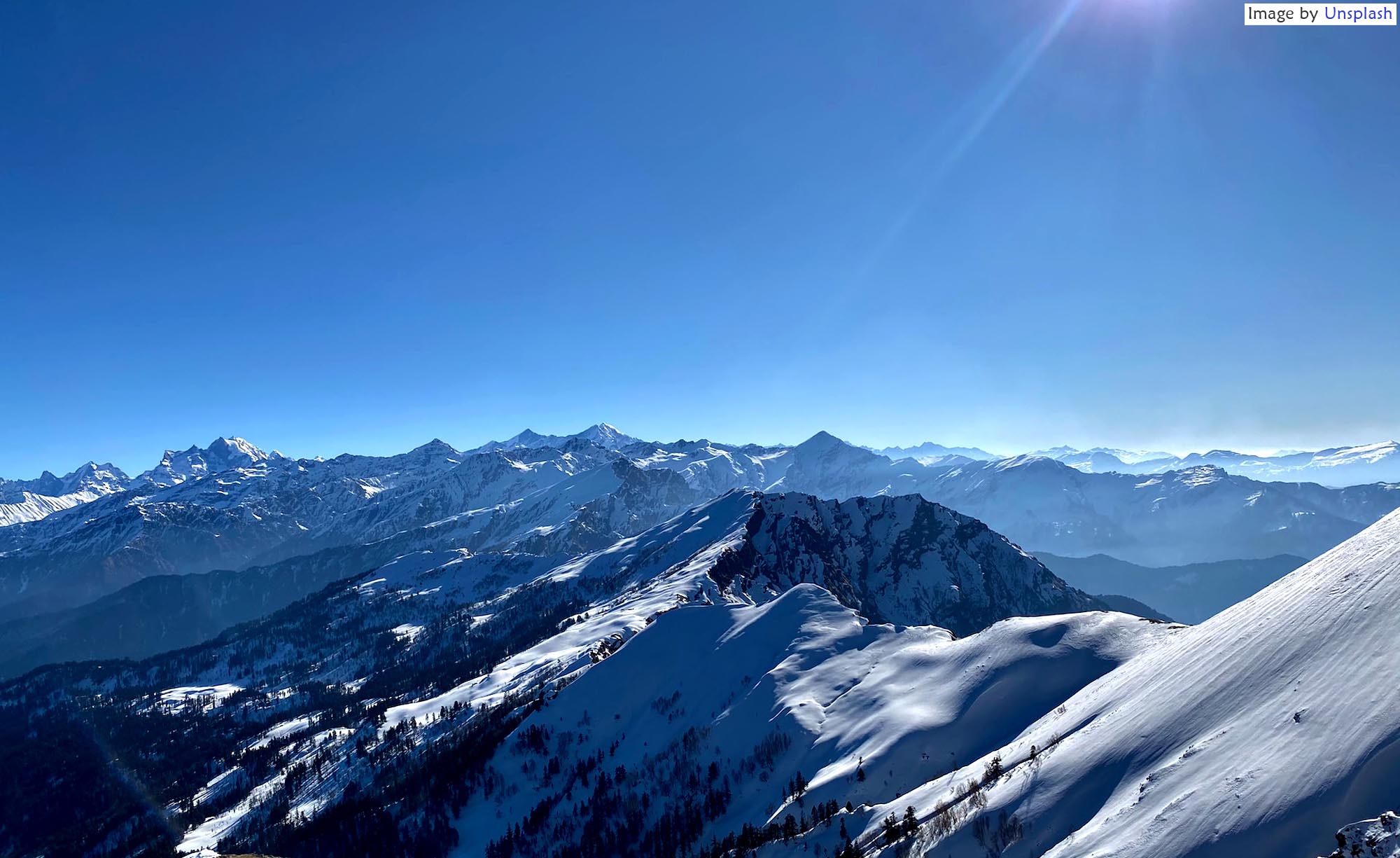

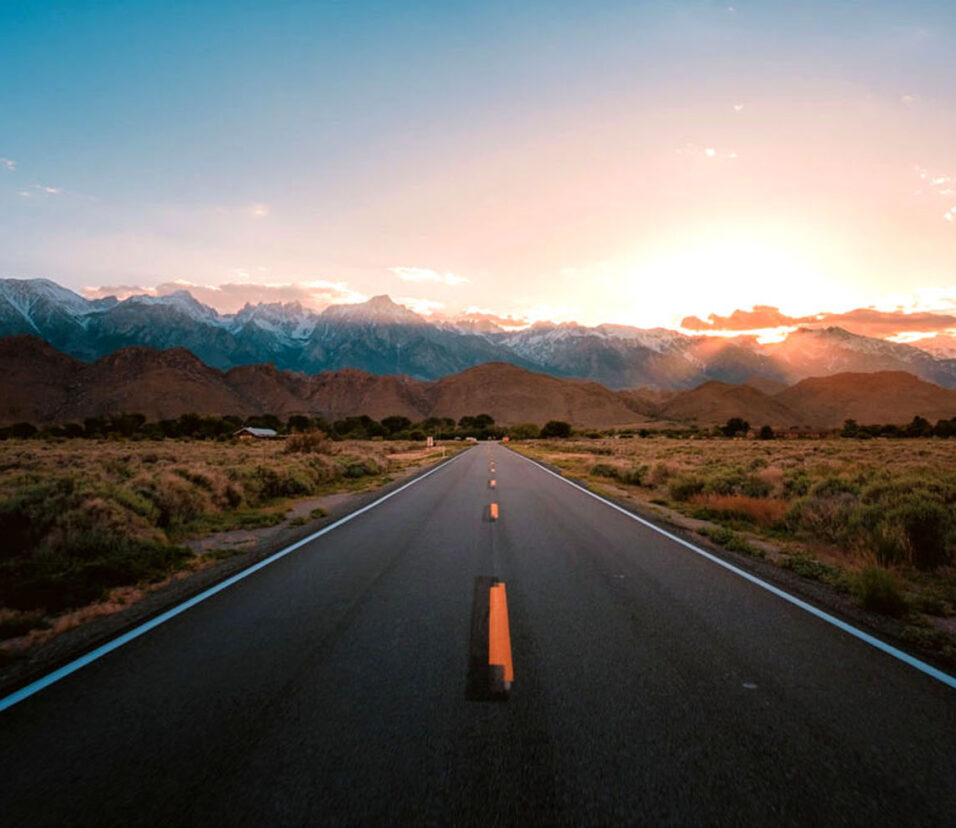
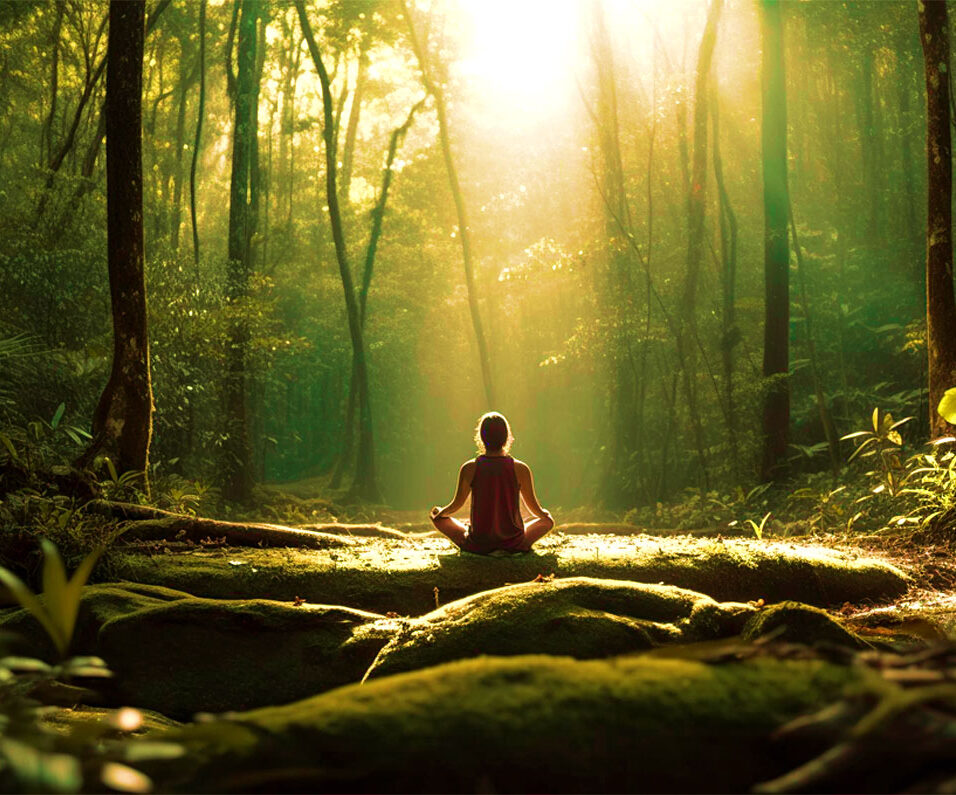

Leave feedback about this